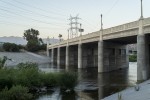As summer nears, the Los Angeles River Revitalization project is making quite the splash – monopolizing news coverage and maybe even hiking up Angelenos’ home prices.
The LA River Revitalization project is concentrated in one area, called the G2 parcel, which the city purchased in 2016. The G2 parcel covers an 11-mile strip of the riverfront through the Elysian Valley. Following this purchase, a group called the Friends of the Los Angeles River, a nonprofit aiming to increase the accessibility and sustainability of the river, and other community organizations pushed for an ecologically responsible development plan known as Alternative 20, which would restore 719 acres of river habitats and tear out concrete along the river. As a result of intense lobbying by these community organizers, the U.S. Army Corps of Engineers ultimately recommended Alternative 20 to the city and planning went underway.
The project, initially meant to be a collaborative effort between long-time community activists and the city’s development team, was handed over this year to flashy, world-renowned architect Frank Gehry, instead of small-time urban design architects at Studio-MLA, formerly known as Mia Lehrer + Associates.
This decision marked a turning point in development. Large real estate investments and even smaller, hip businesses are now pushing out locals along the strip by hiking the real estate prices in the area to new highs.
Sound familiar? It should. The LA River Revitalization Project has also become a victim of gentrification. And to a large degree, the city doesn’t care about that.
Los Angeles needs to strike a balance between providing for its communities by investing in projects that will improve the health of its residents in the long term without simply generating new areas of lucrative investment for real estate companies and prime retail location for latte-loving hipsters.
The solution to gentrification might not seem like a simple one – it isn’t, but it shouldn’t stop LA from trying. If the city honors community voices and incentivizes affordable homes in the newly developed areas, we might finally see the changes we’ve been hoping for when it comes to developing underserved areas.
That’s not to say that LA’s intentions with the river revitalization project weren’t pure at first. But over time, its values have shifted.
It isn’t just about the river and its appeal to investors. The project raises a bigger question of how Los Angeles can invest in underdeveloped and underserved areas without attracting millennial hipsters and dreaded micro-breweries, or rather, without throwing up its hands in the face of gentrification.
The Prevention Institute, a nonprofit intent on creating community-oriented solutions to problems like displacement, recently published a paper that explores different opportunities to support marginalized communities. One of the key ways it recommends for avoiding displacement and gentrification is community involvement in decision-making – a value that may just have been abandoned with the revitalization project.
It may seem like this community outreach will be slow-going, ineffective and plagued with low turnout. But Michael Atkins, the communications and impact manager at Friends of the Los Angeles River, said he has seen high turnout at community meetings and events about the river revitalization project, something he believes can help the project along.
“A lot of times, if a robust community-outreach program is done, it will enhance the understanding that the engineers will have and then carry into delivering the amenities the community wants,” Atkins said.
While affordable housing is probably the best way to ensure long-time residents can remain in their communities and enjoy the types of improvements they’ve been asking for, development in other areas of the community should be operating with the same caution. The last thing LA needs, or wants, is more gentrification.
More specifically, the city should be looking for solutions that involve the incentivization of affordable housing or implementation of policies that require community involvement in the planning and development process. It can also be useful to analyze the potential impact that a project might have on a community in regards to displacement.
What is so exciting about this revitalization project is its potential to reduce the risk of gentrification and displacement for the communities along the riverfront. The less obvious potential for the project lies in its ability to revolutionize the city’s development practices. If LA can shift the way it approaches these sorts of community-improvement operations, the city will have found a way to improve the communities and avoid relinquishing more valuable space to wealthier groups.
The city has an opportunity to break away from this usual gentrification, rather than simply offering up new land for commercial real estate, bougie cafes and hiking trails that only attract wealthier Angelanos. It can push for the improvement of community health, which is heavily impacted by the sorts of displacement Elysian County is currently headed to, without encouraging an influx of high-income renters.
All this collaboration requires LA officials to keep in mind how valuable a community’s voice can be and ensure it isn’t drowned out by the excitement of a high-profile river development project.

oh, dear. SO many misleading errors in this piece (a few of them guffaw inducing, so um thanks for that?) Lazy, lazy, lazy. Please don’t try writing about the river ever again. Making Bruins look bad.
Community outreach and rent vouchers won’t solve underinvestment and LA’s failure to build adequate housing supply. Dense construction on the riverbank would be good for the environment, and both potential and existing residents.
“gentrification is a problem” = “people of (x) race moving into my neighborhood is a problem”